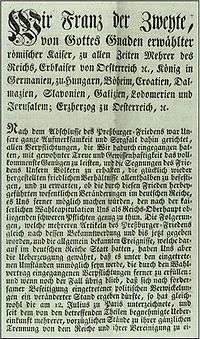Dissolution of the Holy Roman Empire

Printed version of the abdication of Francis II, Holy Roman Emperor
The dissolution of the Holy Roman Empire occurred de facto on 6 August 1806, when Emperor Francis II abdicated his title and released all imperial states and officials from their oaths and obligations to the empire. Although the abdication was considered legal, the dissolution of the imperial bonds was not and several states refused to recognise the end of the empire at the time.[1]
External links
- Abdication of Francis II on Wikisource
Notes
- ↑ Gagliardo 1980, p. 281.
Sources
- Burgdorf, Wolfgang (2012). "'Once we were Trojans!' Contemporary Reactions to the Dissolution of the Holy Roman Empire of the German Nation". In Evans, Robert J.; Wilson, Peter H. The Holy Roman Empire, 1495–1806: A European Perspective. Leiden: Brill. pp. 51–76.
- Forrest, Alan; Wilson, Peter H., eds. (2009). The Bee and the Eagle: Napoleonic France and the End of the Holy Roman Empire. Basingstoke: Palgrave.
- Gagliardo, John G. (1980). Reich and Nation: The Holy Roman Empire as Idea and Reality, 1763–1806. University of Indiana Press.
- Whaley, Joachim (2012). Germany and the Holy Roman Empire, Volume II: The Peace of Westphalia to the Dissolution of the Reich, 1648–1806. Oxford: Oxford University Press.
- Wilson, Peter H. (2006). "Bolstering the Prestige of the Habsburgs: The End of the Holy Roman Empire in 1806". The International History Review. 28 (4): 709–36.
This article is issued from
Wikipedia.
The text is licensed under Creative Commons - Attribution - Sharealike.
Additional terms may apply for the media files.